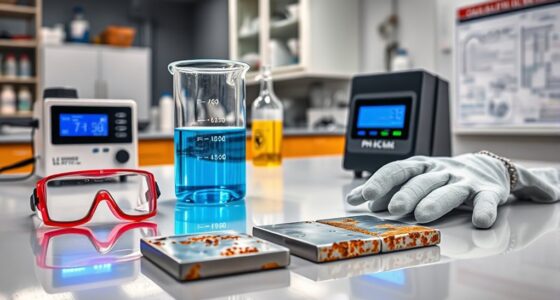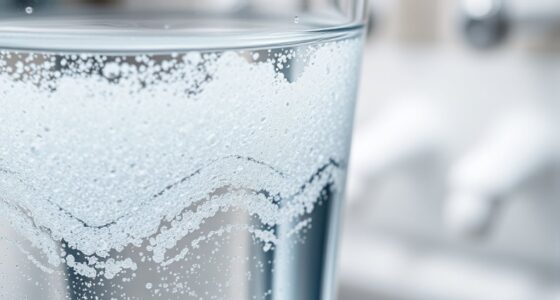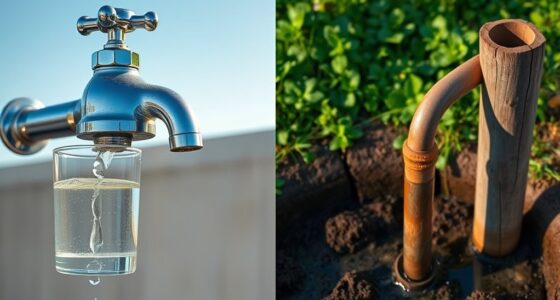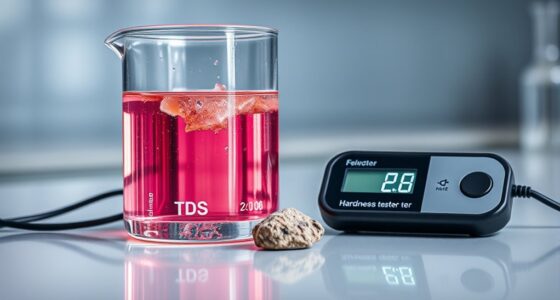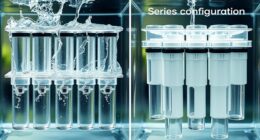To confidently remove chloramine and chlorine from your water, start by understanding their differences: chlorine dissipates quickly, while chloramine remains longer and is harder to eliminate. Use simple tests like smell or taste, and consider using activated carbon filters, which are effective for both. Specialized filters can target chloramine more efficiently. Keep monitoring your water quality and maintenance to guarantee safe, great-tasting water—if you keep exploring, you’ll learn even more.
Key Takeaways
- Understand the chemical differences: chlorine offers quick disinfection, while chloramine provides long-lasting, stable water treatment.
- Use targeted testing kits to accurately detect residual chlorine or chloramine levels in your water.
- Choose appropriate filtration systems: activated carbon for chlorine, specialized catalytic filters for chloramine removal.
- Regularly monitor water pH and mineral content to optimize disinfection effectiveness and filter performance.
- Consider water source quality and personal sensitivity when selecting disinfection methods for safe, clean drinking water.
Understanding Chloramine and Chlorine: What Are They?

Have you ever wondered what exactly chloramine and chlorine are and how they affect your water? To understand this, it’s helpful to know some chemistry basics. Chlorine is a simple, highly reactive element used to disinfect water, killing bacteria and viruses quickly. Chloramine, on the other hand, is a compound formed when chlorine reacts with ammonia. It’s more stable, providing longer-lasting disinfection. In water chemistry, these disinfectants help ensure water safety, but they behave differently. Chlorine tends to dissipate faster, while chloramine remains in the water longer. Understanding the disinfection process is key to understanding how they impact your water quality and what you might need to do to remove them effectively.
The Impact of Chloramine and Chlorine on Water Quality and Safety

You need to understand how chloramine and chlorine affect your water’s purity and safety. These chemicals can impact health and influence treatment effectiveness, making it essential to choose the right removal method. Let’s explore how these factors matter for your water quality. For example, proper water treatment can significantly reduce the presence of these chemicals, ensuring safer drinking water.
Water Purity Concerns
Chloramine and chlorine are commonly added to water supplies to eliminate harmful bacteria and pathogens, but their presence can also raise concerns about water quality and safety. These chemicals can affect the pH balance, making water more acidic or alkaline, which may impact plumbing and appliance longevity. Additionally, they can alter mineral content, potentially leading to corrosion or mineral buildup that affects taste and clarity. If not properly managed, chloramine and chlorine can cause water to feel gritty or metallic, raising doubts about purity. Understanding how these chemicals influence pH levels and mineral content helps you assess water quality more confidently. Ensuring proper removal methods maintains water’s natural qualities while safeguarding your health and home infrastructure. The ongoing integration of automation technologies in water treatment facilities is also expected to improve purification processes and monitoring accuracy, further enhancing water safety.
Health Implications of Chemicals
Although chloramine and chlorine are effective at disinfecting water, their presence can pose health concerns if not properly managed. Residual chemicals may react with organic matter, forming harmful byproducts. These byproducts include pesticide residues and heavy metal contamination, which can compromise safety. Long-term exposure to chloramine and chlorine has been linked to skin irritation, respiratory issues, and other health problems.
| Chemical Type | Potential Risks | Common Contaminants |
|---|---|---|
| Chloramine | Skin irritation, long-term health risks | Pesticide residues, heavy metals |
| Chlorine | Respiratory issues, carcinogenic byproducts | Heavy metals, organic compounds |
Proper removal strategies help ensure your water remains safe and free from these health threats.
Treatment Effectiveness Strategies
Effective treatment strategies are essential for minimizing the health risks associated with residual chloramine and chlorine in drinking water. To do this, you need to monitor water pH closely, as it influences disinfection efficiency and chemical stability. Adjusting pH levels can enhance the removal of chloramine and chlorine, ensuring safer water. Additionally, consider mineral content, which can affect treatment effectiveness; high mineral levels may hinder chemical reactions or clog filtration systems. Using activated carbon filters can adsorb residual chemicals effectively, especially when combined with pH adjustments. Regular testing and tailored treatment plans help maintain water quality, reducing potential health hazards. Notably, understanding the best arcades for home game rooms can inspire practical, space-efficient setup ideas for recreational spaces. By focusing on water pH and mineral content, you optimize your disinfection process, ensuring cleaner, safer drinking water for everyone.
How to Detect Chloramine and Chlorine in Your Water
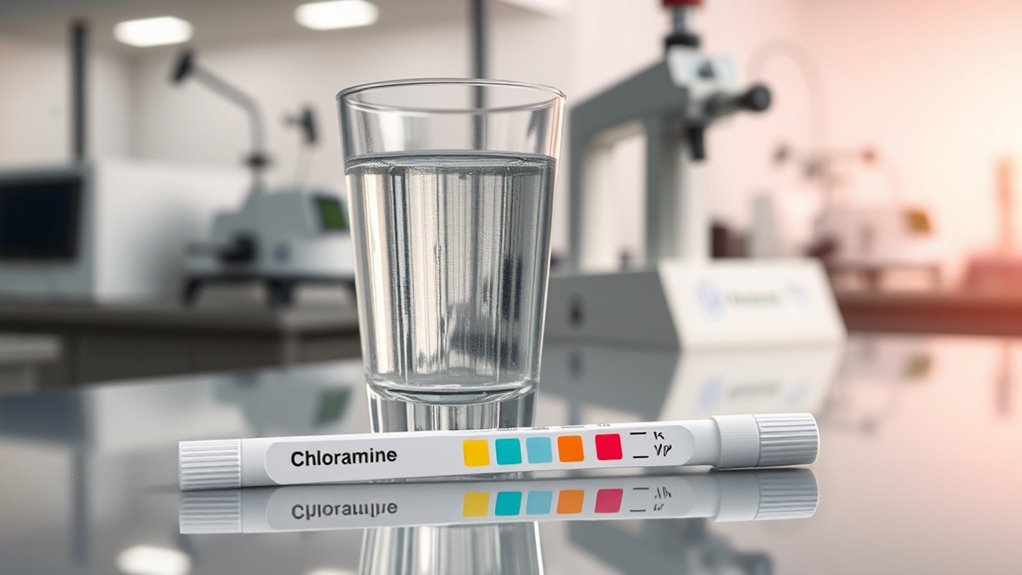
You can often spot chloramine or chlorine in your water by checking its clarity, smell, and odor. Using simple test kits or methods can give you a more accurate reading. Understanding these signs helps you decide if further testing or treatment is needed. Additionally, knowing the types of water testing available can help you choose the most effective method for detecting these chemicals.
Visual Water Clarity
Detecting chloramine and chlorine in your water can often be done simply by observing its clarity. If your water appears cloudy or murky, it might contain these disinfectants. However, clear water doesn’t guarantee purity, so pay attention to subtle differences. Water pH levels can influence how chlorine or chloramine react, affecting their visibility—lower pH can make them more noticeable. Mineral content also plays a role: high mineral levels can cause the water to look cloudy or have a slight haze, masking or mimicking disinfectant presence. While visual clues are helpful, they’re not foolproof. For accurate detection, consider testing kits or professional analysis, especially if your water’s clarity seems inconsistent or you suspect contamination. Frictional unemployment can sometimes create opportunities for innovative water treatment solutions that address these detection challenges.
Smell and Odor Test
Have you ever noticed a distinct smell when running your tap water? That’s often a sign of odor detection, indicating the presence of chloramine or chlorine. To perform a simple smell testing, take a small glass of water and smell it carefully. Chlorine typically produces a strong, bleach-like odor, while chloramine has a more chemical, medicinal smell. Trust your nose—your sense of smell is a quick, effective way to identify these disinfectants. If the water smells heavily of chemicals, it’s likely chloramine or chlorine. This initial smell test helps you determine if further testing or treatment is necessary. Remember, consistent odor detection can warn you of ongoing water quality issues, making smell testing an essential part of your water safety routine. Regular monitoring can also help you understand the sources of pollutants in your water supply.
Test Kits and Methods
To accurately determine whether your water contains chloramine or chlorine, using test kits is the most reliable approach. Water test kits are designed to detect these disinfectants quickly and accurately. Look for kits that measure residual disinfectant levels and can differentiate between chloramine and chlorine. Additionally, some advanced kits assess pH balance and mineral content, which influence disinfection effectiveness and taste. Monitoring pH levels helps understand how disinfectants interact with your water, while mineral content can affect test accuracy. Regular testing ensures you know what’s in your water, helping you choose the right removal method confidently. With proper test kits, you gain clarity and control over your water quality. Studies show that home security systems significantly increase safety and peace of mind when properly implemented, much like accurate testing provides confidence in your water quality.
The Pros and Cons of Chloramine and Chlorine Removal Methods
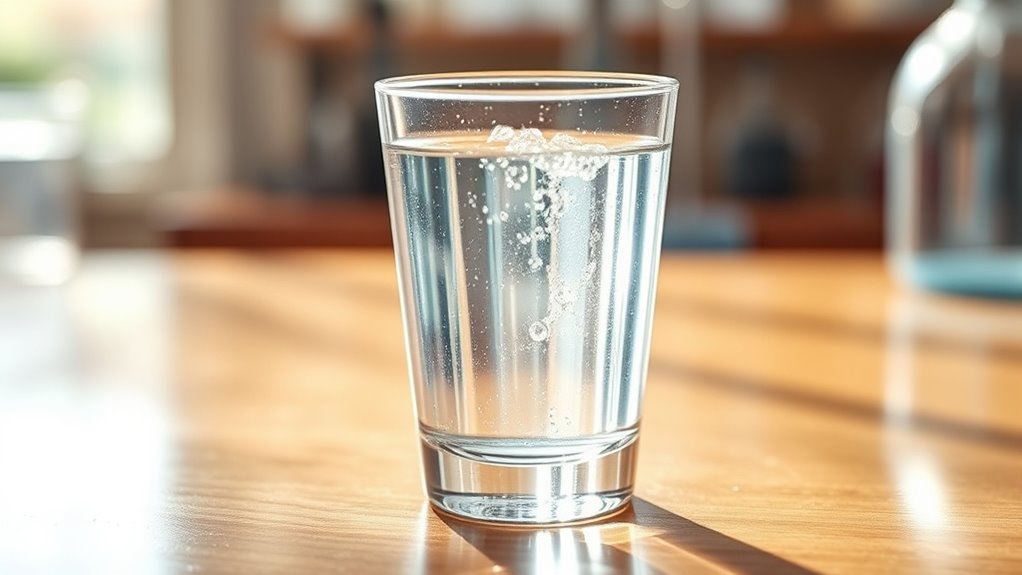
Choosing the right method to remove chloramine or chlorine from your water involves weighing their respective advantages and disadvantages. Water filtration systems vary in effectiveness; some excel at immediate removal, while others may struggle with chemical stability over time. Chlorine removal methods, like activated carbon filters, are simple and cost-effective but can lose effectiveness if not maintained properly. Chloramine removal often requires specialized filtration, which can be more expensive but provides longer-lasting results. The chemical stability of chloramine makes it harder to remove with standard filters, requiring more advanced solutions. Conversely, chlorine is easier to eliminate but may leave residual taste or odor. Understanding these pros and cons helps you choose the method that best fits your needs, ensuring cleaner, safer water. Lifestyle choices, such as maintaining a healthy home environment, can also influence water quality and overall well-being.
Activated Carbon Filtration: The Most Common Solution
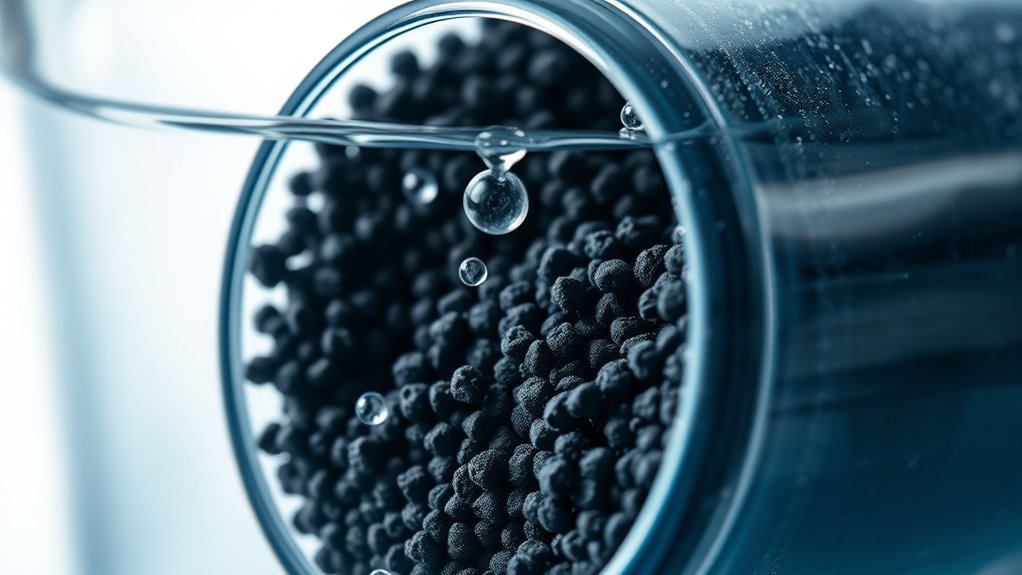
Activated carbon filtration stands out as the most widely used method for removing chlorine and chloramine from drinking water. It effectively absorbs these disinfectants, improving water taste and safety. One of its key benefits is maintaining pH balance, ensuring your water remains neither too acidic nor too alkaline. Additionally, activated carbon filters help retain essential minerals, preserving the water’s natural health benefits. This method is simple to install and cost-effective, making it popular for household use. As water passes through the carbon, contaminants are trapped within its porous surface, providing reliable removal. Regular filter replacement is essential to sustain performance. Overall, activated carbon filtration offers a straightforward, efficient solution for those seeking clean, good-tasting water without sacrificing mineral content or disrupting pH levels. Moreover, it supports local water quality, ensuring your water remains healthy and safe to drink.
Using Reverse Osmosis Systems for Effective Removal

Reverse osmosis (RO) systems are highly effective at removing chlorine, chloramine, and a wide range of contaminants from your water. They work by forcing water through a semi-permeable membrane, trapping impurities and leaving you with clean, safe water. While RO considerably reduces contaminants, it can also strip away beneficial minerals, which affects pH balancing. To maintain ideal water quality, consider remineralization filters that add essential minerals back into the water, supporting healthy pH levels. RO systems excel at providing pure water, but it’s important to monitor mineral retention to prevent overly acidic or flat-tasting water. Properly maintained, an RO system offers a reliable solution for removing chloramine and chlorine, giving you confidence in your drinking water’s safety and quality.
The Role of Catalytic Carbon and Specialty Filters
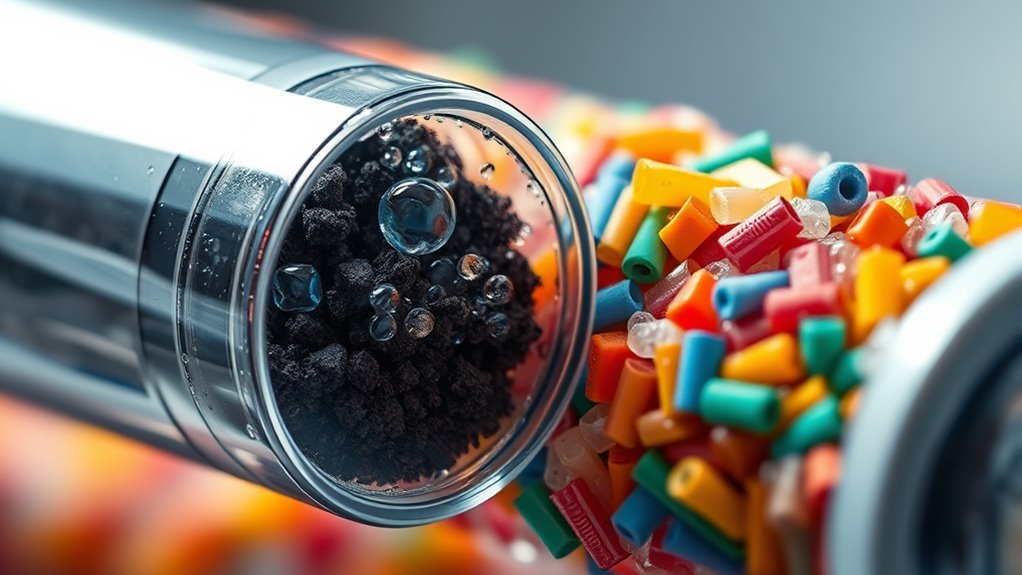
Catalytic carbon and specialty filters are highly effective at targeting chloramines and chlorine, thanks to their enhanced efficiency. These filters can remove contaminants more quickly and thoroughly than standard options, making your water cleaner and safer. Understanding their advantages helps you choose the right filtration system for your needs.
Catalytic Carbon Efficiency
While standard carbon filters can reduce chlorine and chloramine levels, catalytic carbon specializes in breaking down these compounds more efficiently. This enhanced efficiency means your water retains better pH balance and mineral content, which are crucial for taste and health. Catalytic carbon’s unique surface accelerates chemical reactions, ensuring chloramines are removed faster and more completely. Unlike regular filters, it maintains the natural mineral profile of your water, preserving essential nutrients. This results in cleaner, better-tasting water without compromising your water’s stability. You’ll notice improved filtration performance, especially in systems dealing with chloramine-heavy water. By choosing catalytic carbon, you optimize removal, protect your water’s mineral balance, and enjoy more consistent, high-quality drinking water every day.
Specialty Filter Advantages
Specialty filters, such as catalytic carbon, offer significant advantages when it comes to water purification. These advanced filtration materials target specific contaminants like chloramine and chlorine more effectively than standard filters. Catalytic carbon enhances the removal process by breaking down chloramines, which are harder to filter. Additionally, specialty filters allow for system customization, so you can tailor your water treatment setup to address your unique water quality concerns. This customization ensures you’re removing impurities more efficiently and achieving cleaner, better-tasting water. By incorporating specialty filters into your system, you gain the ability to optimize filtration for various contaminants, providing peace of mind and confidence in your water quality. Ultimately, these filters deliver superior performance and adaptability for your purification needs.
Chemical Treatments and Additives for Water Purification
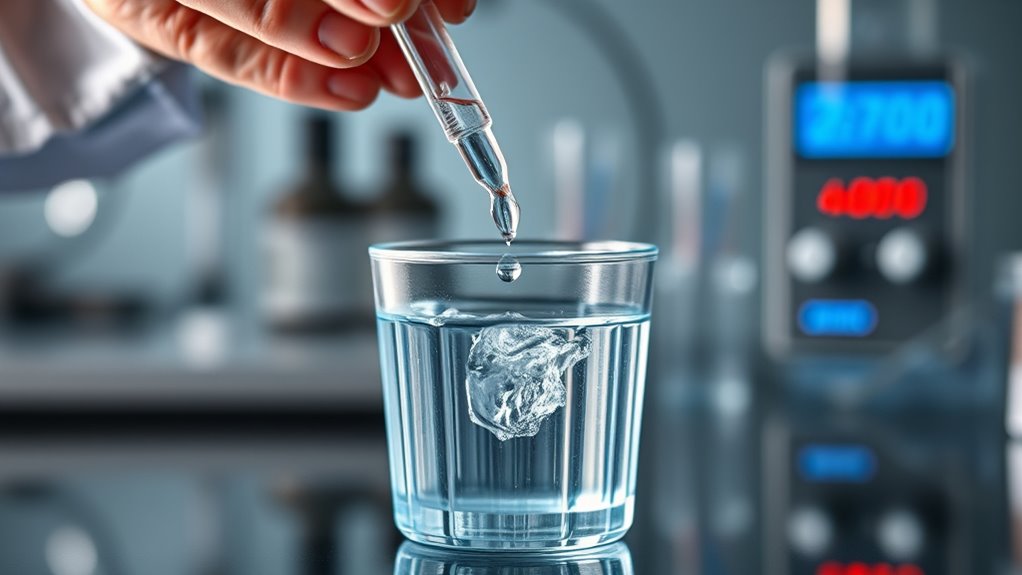
Chemical treatments and additives play a essential role in water purification by effectively eliminating contaminants and guaranteeing safe drinking water. pH adjustment is key because it helps optimize water chemistry, preventing corrosion and improving filtration efficiency. Balancing minerals ensures your water maintains the right levels of essential nutrients, which can improve taste and prevent health issues. Additives like pH buffers or mineral blends are used to fine-tune water quality, making it safer and more palatable. These treatments work alongside filtration systems to target specific impurities, such as heavy metals or organic compounds. Proper use of chemical additives can also extend the lifespan of your filters and reduce maintenance needs. By carefully applying these treatments, you create a more reliable and healthier water supply tailored to your needs.
Tips for Maintaining and Monitoring Your Water Treatment System

Regularly maintaining and monitoring your water treatment system is essential to guarantee it functions effectively and provides safe, clean water. Check filters and disinfection components regularly to prevent buildup and ensure peak performance. Keep an eye on water softening systems; if minerals like calcium and magnesium accumulate, they can reduce efficiency and cause scale. Test your water’s pH levels frequently to maintain proper pH balancing, which helps prevent corrosion and enhances treatment effectiveness. Clean and service your system as recommended by the manufacturer to avoid malfunctions. Monitoring water quality through simple test kits can alert you to issues early. Consistent upkeep ensures your system reliably removes chloramine or chlorine, maintaining water safety and quality for your household.
Making an Informed Choice: Which Method Is Right for You?

Choosing between chloramine and chlorine for water treatment depends on your household’s needs and preferences. Start by conducting water testing to understand your water’s specific contaminants and levels. Chlorine is effective for quick disinfection, but it can produce unpleasant taste and odor. Chloramine lasts longer and is gentler on plumbing, but it requires different removal methods. Your decision should consider your water quality, sensitivity to chemicals, and whether you prefer a simple or more thorough solution. Filtration systems can help remove either disinfectant, but not all filters are equal. For chloramine, look for activated carbon filters designed specifically for its removal. By testing your water and choosing the right filtration system, you’ll make an informed choice that ensures safe, great-tasting water for your household.
Frequently Asked Questions
How Long Does It Take to Remove Chloramine and Chlorine From Water?
It typically takes about 24 to 48 hours to fully remove chloramine and chlorine from water through standard treatment methods. Removal timelines depend on factors like water volume, treatment method, and temperature. Using activated carbon filters or chemical neutralizers can speed up water treatment durations, often reducing removal time to just a few hours. To guarantee safe drinking water, it’s best to test periodically and follow recommended treatment procedures.
Are There Any Health Risks Associated With Chloramine and Chlorine Exposure?
Think of chloramine and chlorine as invisible fog, silently creeping into your health. While small amounts generally don’t cause immediate harm, prolonged chemical exposure can lead to health concerns like skin irritation, respiratory issues, or other long-term effects. It’s wise to minimize your exposure by using water filters, especially if you have sensitive skin or respiratory conditions. Staying informed helps you protect yourself from potential risks lurking in your tap water.
Can Household Water Filters Completely Eliminate Chloramine and Chlorine?
Household water filters can considerably reduce chloramine and chlorine, but their filtration efficiency varies depending on the filter type. Activated carbon filters excel at chemical breakdown, removing most chlorine and chloramine effectively. However, no filter can guarantee complete elimination. To maximize removal, choose high-quality filters specifically designed for chloramine and chlorine, and regularly replace them to maintain ideal performance.
What Are the Cost Differences Between Various Removal Methods?
Think of water treatment like buying a car—some options cost more upfront but save money long-term. For household filters, activated carbon systems have lower installation costs but require frequent replacement, increasing maintenance expenses. Reverse osmosis units cost more initially but are more thorough, saving you money on bottled water. Consider your budget and needs to choose the most cost-effective method, balancing installation costs and ongoing maintenance.
How Often Should I Replace or Maintain My Water Filtration System?
You should replace or maintain your water filtration system based on its filter lifespan and your maintenance schedule. Typically, filters need changing every 6 to 12 months, but check the manufacturer’s recommendations for your specific model. Regular maintenance, like cleaning and inspecting for clogs, guarantees maximum performance. Stay attentive to any changes in water taste or flow, which might signal it’s time for a replacement or maintenance to keep your water clean and safe.
Conclusion
By understanding the differences between chloramine and chlorine, you can choose the right removal method for your water. For example, if your city uses chloramine, installing activated carbon filters can effectively eliminate it, ensuring safer drinking water. Regular maintenance and monitoring are key to maintaining water quality. When you stay informed and select the appropriate treatment, you’ll enjoy cleaner, safer water—just like Sarah did, transforming her tap water into a confident, revitalizing experience.


